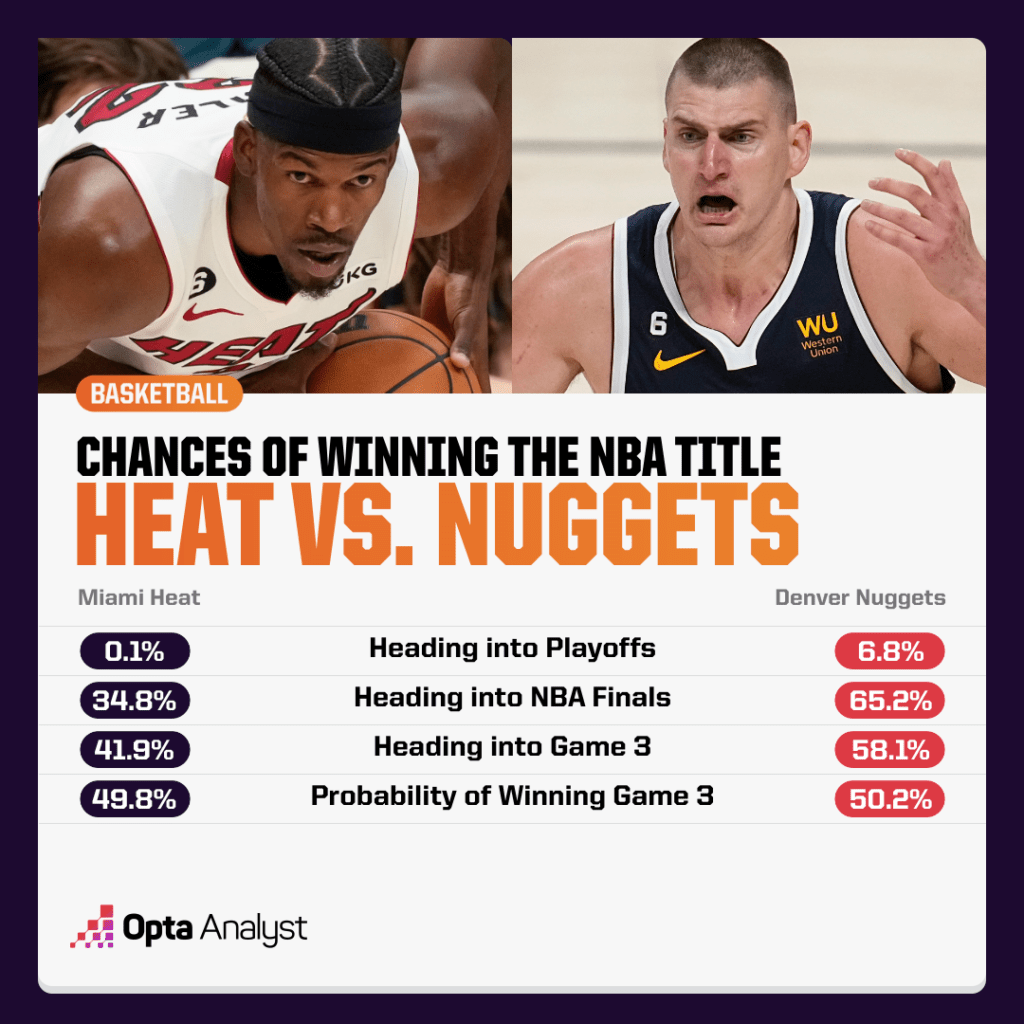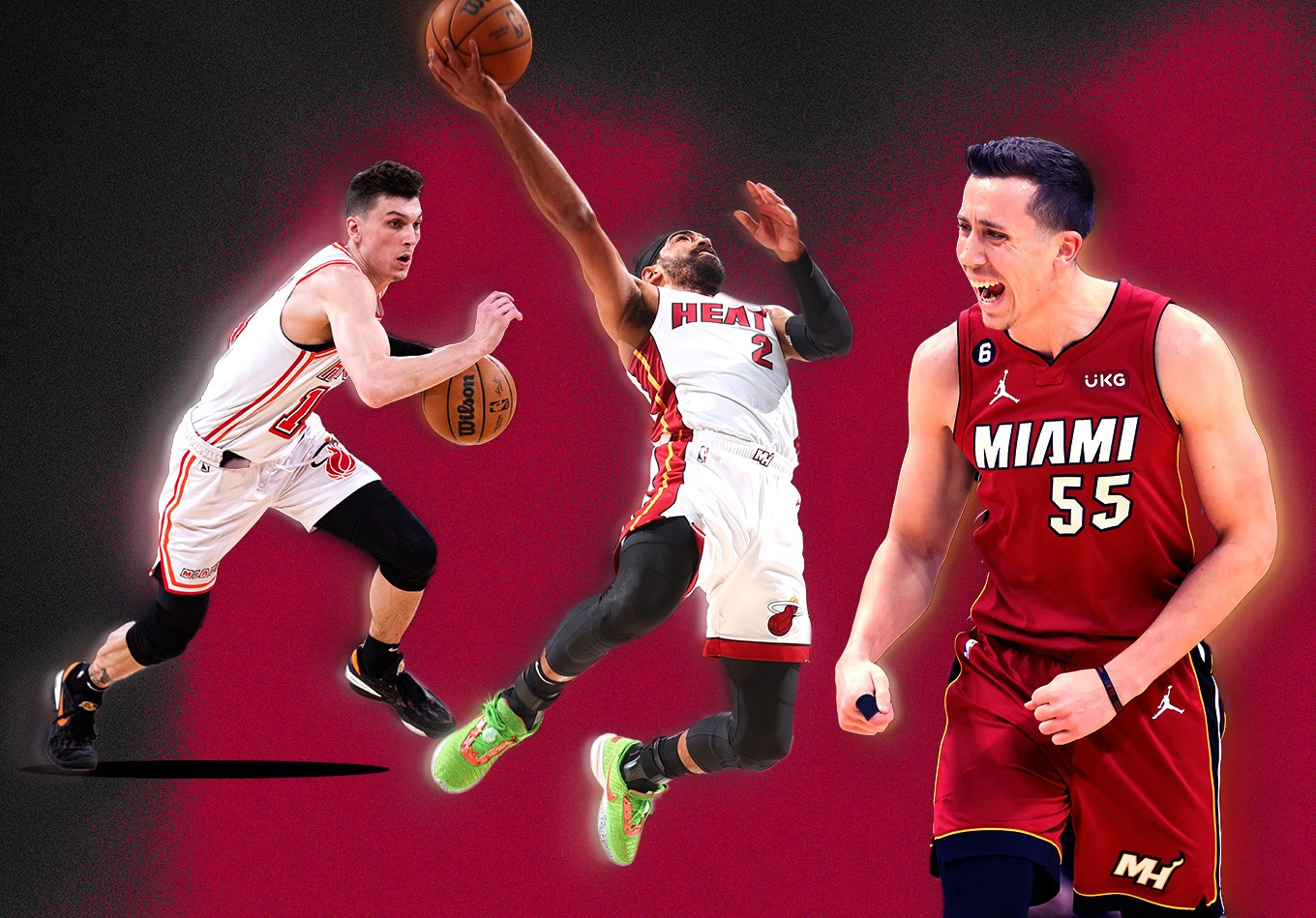Tyler Herro, the Heat’s third-leading scorer at 20.1 per game during the regular season, still hasn’t been cleared for Game 3. Miami’s supporting cast, however, proved that in Game 2 that these upstarts don’t need him to take down the Nuggets.
In Game 1 of the NBA Finals, the Miami Heat offense was on life support.
Amid a 104-93 loss to the Denver Nuggets, the Heat yielded an offensive rating of 99.1. (The Charlotte Hornets finished last in the league during the regular season at 106.7.)
Miami repeatedly settled for the first look it found, rarely challenged Nikola Jokić at the rim, enabled him to camp in the paint and ran much of the offense through Bam Adebayo as a scorer in the middle of the floor.
Three days later, the Heat’s offense flourished in a 111-108 victory to steal home-court advantage and knot this series at 1-1 heading back to Kaseya Center for Wednesday’s Game 3. They scorched the nets en route to a 123.6 offensive rating. (The Sacramento Kings led the NBA at 117.0 in the regular season.)
Behind a combination of stylistic tweaks, white-hot outside shooting (17 of 35 from beyond the arc) and Denver’s wretched defensive performance, the Heat handed the Nuggets their first home loss in 10 games this postseason.

On Thursday, Denver invited Miami to funnel much of its offense through Adebayo in single coverage against Jokić, possessions that often resulted in contested midrange jumpers. He scored 26 points on a playoff career-high 25 shots. He played fairly well, but that is not the formula for offensive potency for the Heat.
On Sunday, Adebayo had 20 points on 14 shots, looking much more like the complementary creator, agile roller, hulking screener and high-post playmaker who has earned a pair of All-Star berths. With Adebayo sliding back into secondary scorer behind Jimmy Butler and donning the role of conduit, a trio of Miami’s vital ancillary options broke loose. Gabe Vincent, Max Strus and Duncan Robinson combined for 47 points on 27 shots.
They buried 10 of their 19 long balls and handed out 10 assists to one turnover. All of them tout immense shooting gravity (albeit to different levels), but they’re by no means confined to off-ball shooting and that helps diversify Miami’s offense.
Adebayo as the primary hamstrung Miami’s collective efficiency. Since spraining his ankle in Game 1 of the second round, Butler seems to lack his traditional verve and explosiveness. To compensate for those realities, Vincent, Strus and Robinson all illuminated their multifaceted repertories.
Strus followed up his 0-for-10 performance in Game 1 with four triples in the first quarter, repeatedly flummoxing Denver via ghost screens. He also showcased his ball-handling chops to set up Adebayo occasionally. Robinson ignited Miami’s title wave fourth quarter with 10 points on 4-of-4 shooting in the opening two minutes and 30 seconds and none of his buckets were zero-dribble 3s.
Vincent’s pick-and-roll prowess gave the Heat an avenue to target Jamal Murray – who struggled all night defensively – beyond Butler hunting him. Whereas Strus and Robinson’s surges bookended Miami’s win, Vincent was a steady, versatile presence, leaving his mark every single quarter offensively.
All of this put less of an emphasis on the fact that Tyler Herro, the team’s third-leading scorer (20.1) during the regular season, still hasn’t been cleared to play in Game 3 as he continues to recover from a broken hand he suffered in the opening game of the playoffs against the Milwaukee Bucks.
Although the Heat’s shot profile wasn’t radically different from Game 1 (they predominantly swapped some shots at the rim for 3s), their process was much cleaner and extensive.
According to inpredictable, their average time of possession increased to 14.2 seconds after sitting at 12.2 seconds in Game 1. They were methodical. They didn’t settle for the first available look and play into Denver’s hands, which happened a fair amount to begin this series.
To some extent, that’s the upshot of deploying Adebayo as a screener and DHO trigger man more than as an isolation scorer in space. This isn’t a criticism of Adebayo but rather an acknowledgement of how his shifting usage alters Miami’s pace of play and quality of possessions. He is best offensively in the gig he enjoyed Sunday, not the overextended gig the Nuggets’ Game 1 defense spurred, when he’s helping facilitate slower developing sets rather than hosting a one-man show.
The Heat and their adjustments deserve praise. They did not let Denver dictate the terms of engagement on that end like they did previously. Their shot-making was also extraordinary. A serious tip of the cap is in order (go watch all their makes in quick succession, it’s worthwhile, I promise).
But my goodness, was the Nuggets’ defense putrid. After turning a corner through much of the playoffs, they looked confused, out of sync and unsure of their coverages, particularly as it pertained to switching or not switching. They botched numerous screens, were poorly positioned off the ball and gifted Miami a bunch of favorable shots.
Murray, Michael Porter Jr. and Kentavious Caldwell-Pope, the last of whom also committed six fouls resulting in 12 free throws, were the most prevalent offenders. Aaron Gordon joined the party as well. The communication and execution were bewildering.
Miami nailed the details offensively. It dialed up more staggered picks and perimeter-player-on-perimeter-player screens to bring less adept screen navigators like Murray and Porter into the fold. Butler didn’t shoot well, though he drove twice as many times than in Game 1 (19, up from eight, per NBA.com), and was a shrewd and frugal distributor (nine assists to one turnover).
Off-ball positioning and movement to occupy or punish help defenders was on point. Denver employs significant, aggressive nail and gap help. Miami didn’t handle it very well in Game 1. It did in Game 2. Shooters were stationed well beyond the arc to elongate closeouts. Off-ball motion eased spacing tensions. Jokić was on the move and out of the paint more frequently.
Possessions like these aren’t necessarily the leading reasons the Heat have tied up this series. Yet they’re emblematic of a retooled approach that helped restore offensive mojo and solve the Nuggets – at least for an evening.
The Heat just produced their highest offensive rating of the playoffs.
It came on the backs of their third-highest 3-point rate (.439) and fifth-highest long-range clip (48.6%) of the playoffs. That’s all connected. Variance matters, but less than the manner in which Miami fashioned that volume and how Denver’s own foibles enabled those occurrences. Those are the most salient parts of Game 2 and represented substantial changes from Game 1.
Each side’s encore to such developments may determine Game 3 – with or without a Herro in Miami.
Like this? Follow us on Twitter for more.
